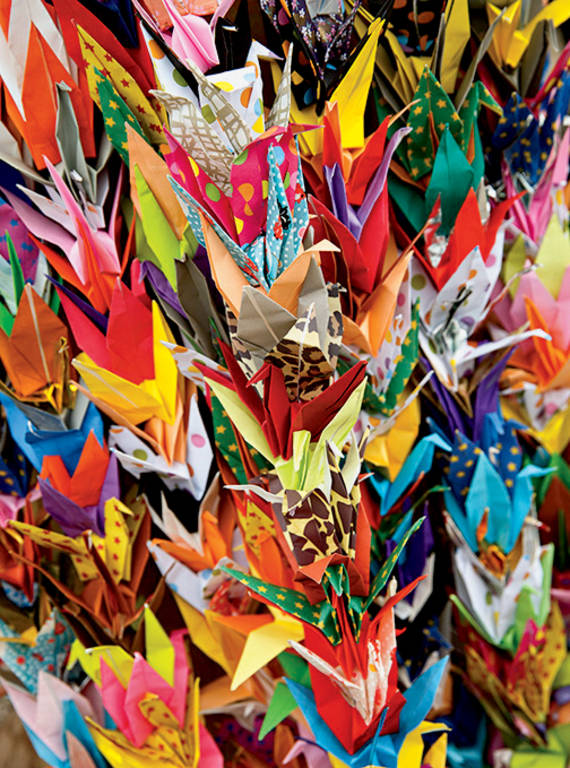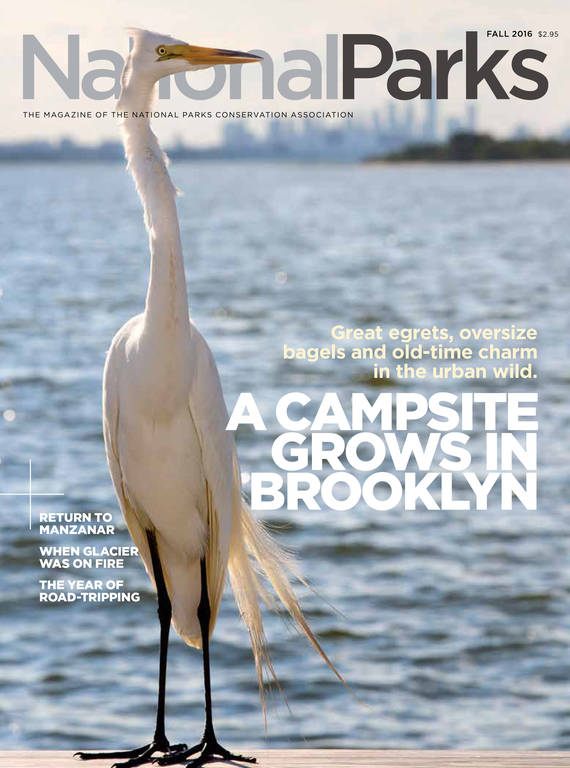Fall 2016
Return to Manzanar
As the number of Japanese-American incarceration camp survivors dwindles, a new generation strives to keep the story alive.
The slow procession moved clockwise around the perimeter of the Lone Pine High School gymnasium. Every few steps, participants paused to read the quotes on posters lining the walls — most from people who had been incarcerated in America’s detention camps during World War II because of their Japanese ancestry. The silence that prevailed gave an air of sanctity to the hangar-like structure. Moments later, after the crowd of nearly 200 had taken their seats, seven Japanese-American college students walked up to read some of the quotes aloud.
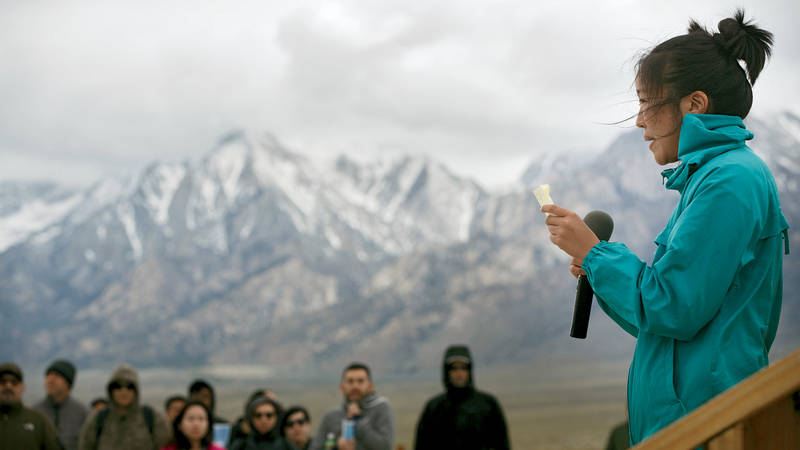
Rena Ogino, a student at University of California, San Diego, speaks to the crowd at the 47th Manzanar pilgrimage.
© PATRICK T. FALLONRena Ogino began, but instead of reading the words of those who had been detained, she chose to start with a statement that David Bowers, then the mayor of Roanoke, Virginia, issued in November 2015. He had summoned the memory of the forced removal of Japanese-Americans and Japanese residents during the war to justify his refusal to welcome Syrian refugees to his city: “I’m reminded that President Franklin D. Roosevelt felt compelled to sequester Japanese foreign nationals after the bombing of Pearl Harbor, and it appears that the threat of harm to America from ISIS now is just as real and serious as that from our enemies then.”
The second quote was from February 1942, more than 70 years earlier. Lt. Gen. John L. DeWitt, commanding officer of the Western Defense Command, said in a report to the secretary of war that U.S. residents and citizens of Japanese descent were an “enemy race” and could not be trusted to remain loyal to the United States: “The very fact that no sabotage has taken place to date is a disturbing and confirming indication that such action will be taken.”
Every year on the last Saturday of April, Japanese-Americans who were incarcerated congregate with family and other supporters at Manzanar National Historic Site for a day of remembrance, but as the number of those who experienced the camps dwindles, the burden is shifting to younger generations, and people like Ogino, to perpetuate their story. These advocates believe this is an urgent task — not only because firsthand witnesses are fast disappearing, but because they are dismayed by the current political discourse. Before the U.S. government sent more than 110,000 Japanese-Americans living on the West Coast to the Manzanar detention camp and nine other so-called relocation centers, that community experienced increasing levels of discrimination and prejudice. Camp survivors, their descendants and others who have become familiar with the story say the current rhetoric targeting Muslims echoes the fearmongering that immediately preceded a dark episode of this country’s history, and they want to sound the alarm.
“You can’t just save your own story,” said Ogino, a student at University of California, San Diego. “We have to also remember that these stories are really alive in other communities today.”
Earlier that day, about 10 miles north of Lone Pine’s high school, about 1,000 people had assembled near Manzanar’s cemetery on the western edge of the former camp. Most of the attendees had traveled on buses from various cities in California, where many Japanese-Americans resettled after the war. A fresh coat of snow had blanketed the summits of the Sierra Nevada to the west, and a relentless wind chilled participants through their blankets, layers of clothing and winter jackets. In this frigid spring weather, you could begin to imagine what it must have been like to spend your first winter at Manzanar in poorly insulated barracks, wearing inadequate clothing.
NPCA AT WORK
The diverse crowd included dozens of people who had been incarcerated at Manzanar and other camps. Those born in camp are now in their mid-70s. The most senior survivors are two decades older, but most carried themselves with a spryness that belied their age. Perhaps it was simply the result of self-selection — those too frail decided not to make the trip — but it was tempting to attribute it to “gaman” spirit, a Japanese virtue of endurance and perseverance. As in recent years, a group of Muslim students also attended. The mood was solemn, and on occasion, people shed tears.
As the co-chair of the Manzanar Committee, the group that has been organizing the pilgrimage for nearly 50 years, Bruce Embrey has a very personal connection to the Manzanar story: His mother, Sue Kunitomi Embrey, was a teenager when she arrived at Manzanar with her family. Camp life actually offered opportunities for young people like her, who often spoke better English than their parents. Kunitomi Embrey became the editor of the Manzanar Free Press, the camp’s ironically named newspaper. Later, as she reentered civilian life, she realized that a lack of political power before the war had left Japanese-Americans vulnerable. “It hit her that our community was powerful economically,” her son said, “yet they got locked up, and all of that got taken away in a flash.”
Making sure it wouldn’t happen again to anyone required increasing the political influence of Japanese-Americans and other minority groups. So she immersed herself in political activism, working to protect women’s and workers’ rights and building relationships with minority organizations in the process. She didn’t direct any of her energy toward Manzanar; in fact, she kept memories of camp life buried. An invitation to join a pilgrimage to the site of the camp in 1969 would change that. As one of the attendees who had been incarcerated there, Kunitomi Embrey found herself answering questions from the media covering the event. The next year, she co-founded the Manzanar Committee, and she became a main organizer of the pilgrimage. She led campaigns to make Manzanar a state and national historical landmark, and then a national park site. After she and her allies secured the National Park Service designation in 1992, Kunitomi Embrey continued to make the annual pilgrimage. She listened to her last one by phone from her hospital bed in 2006. She died two weeks later.
Her son is soft-spoken, but the comments by Bowers and others justifying the use of incarceration camps and discrimination against a minority group have left him angry. And so it was with a forceful tone that he spoke into the microphone on pilgrimage day.
“There are voices daily that we want to counter,” he said. “We must say that no one, no people, regardless of where they came from, what language they speak, what religion they practice, should ever lose their constitutional rights and be incarcerated or vilified simply for looking like the enemy.”
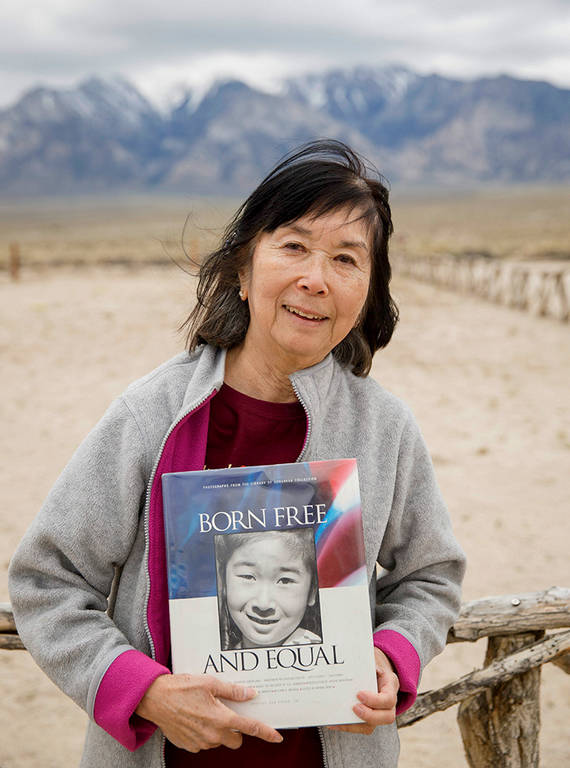
Joyce Nakamura Okazaki, 82, holds a book by Ansel Adams featuring a picture the famed photographer took of her when she was incarcerated at Manzanar.
© PATRICK T. FALLONJapanese immigrants had faced prejudice since they arrived in the country decades before the war, but what followed the attack on Pearl Harbor on Dec. 7, 1941, was of a different magnitude altogether. Fears of a Japanese invasion and — unsubstantiated — allegations of sabotage from within turned the entire Japanese-American community into a scapegoat. Japanese-Americans were routinely insulted and heckled in public, and calls for their removal from the West Coast rose quickly. “Let ’em be pinched, hurt, hungry, and dead up against it,” wrote syndicated columnist Henry McLemore in early 1942. “Personally, I hate the Japanese and that goes for all of them.”
There were voices — even within the government — that spoke out against the unwarranted accusations of disloyalty, but Roosevelt bowed to military pressure, and on Feb. 19, 1942, he signed the infamous Executive Order 9066 authorizing the mass removal of Japanese-Americans to detention camps. The military wasted little time. Once registered, most of those of Japanese ancestry had two weeks or less to prepare for their departure. Many had to sell homes, farmland and businesses at bargain prices to buyers taking advantage of their predicament, losing in days the fruits of decades of hard labor. People could bring only what they could carry, so they left behind pets, family heirlooms and other prized possessions. “I was a kid, so the hardest part was not being able to take my toys,” said Joyce Nakamura Okazaki, who was 7 at the time.

Takashi Hoshizaki and 62 others challenged the legality of being drafted while incarcerated at the Heart Mountain camp in Wyoming. He spent two years in federal penitentiary but was later pardoned by President Harry S. Truman.
PATRICK T. FALLONBecause the camps weren’t built yet, people were rounded up at what the government called “assembly centers” — fairgrounds or stables located all over the West Coast — with no idea of their final destination. In the rush, some families were separated. Bo Sakaguchi, 91, said a little girl who would later become his wife happened to be hospitalized at the time, and she was left behind when her parents were sent to camp. “So my wife had to stay in the hospital by herself,” he said. “At 7 years old, separated from her family, can you imagine how she must have felt?”
The actual camps were systematically located in remote places with extreme climates. All of the detainees had packed light by necessity, so the first winter was a shock. “It got down to minus 28 degrees, and we were in Southern California clothes,” said Takashi Hoshizaki, 90, who was sent with his family to the Heart Mountain camp in Wyoming. Barracks were hastily built and let in cold air and dust. With the collar of his red fleece up to protect himself from the frigid wind, Sakaguchi said the asthma his sister contracted in Manzanar led to the pneumonia that would take her life shortly after she left the camp.
As he walked out of one of Manzanar’s rebuilt barracks, Sam Shimada, who was 9 when he was sent to the Amache camp — originally known as the Granada Relocation Center — in Colorado, said the biggest challenge was adjusting to “American” food. “They fed you sausage and sauerkraut,” he said. “Everybody said, ‘What is that?’”
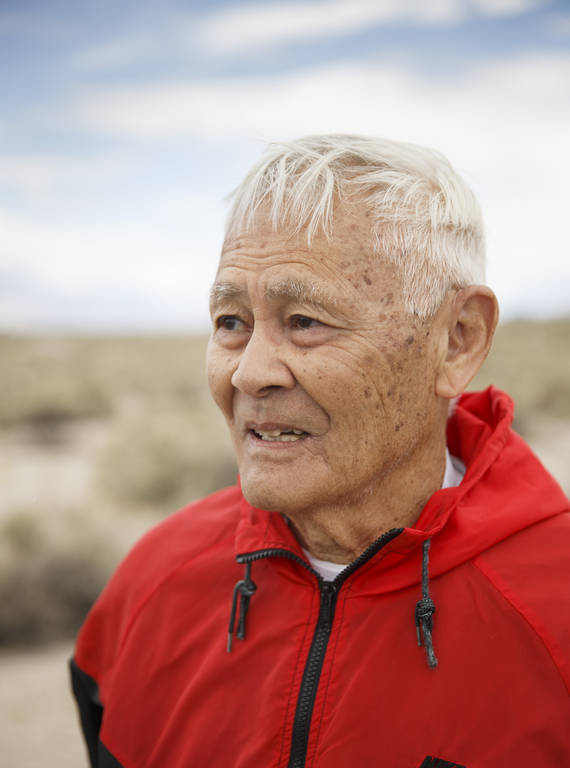
Shigeru Yabu, 84, remembers the games he played as a young child incarcerated in the Heart Mountain camp in Wyoming, but he also remembers the hardships he and his family endured in camp and after their release.
PATRICK T. FALLONWhile the conditions were universally harsh, especially at the beginning, individual experiences differed widely based on the detainees’ age, family circumstances and personal outlook. Shigeru Yabu’s friends say he has an unorthodox take on camp life. “Basically, I enjoyed it as a kid,” he said of his experience at Heart Mountain. Yabu, 84, hasn’t forgotten the cold nights and the series of menial jobs his parents were reduced to taking in a discriminatory post-war climate. But he also remembers his ant farm, his pet magpie Maggie, the games older teenagers taught him at the recreation hall and the escapades beyond the barbed wire to a nearby river.
Sitting in a motel room on the eve of the pilgrimage, Hoshizaki, his good friend, said he has a hard time seeing any silver lining in his Heart Mountain experience. That’s in part because as a teenager, he was old enough to understand the injustice of the incarceration and the devastating effect it had on his family. Also, Hoshizaki was required to fill out what came to be known as the “loyalty questionnaire.” In 1943, the government made all detainees 17 or older fill out a document designed to identify those “loyal” to the United States, asking them, among other things, whether they would be willing to serve on combat duty in the U.S. armed forces. Hoshizaki said he had no intention of dying for the country that had put his family behind barbed wire. “I said, ‘No, I’m not going because this is crazy,’” he said. (Some detainees did volunteer for combat, and their unit became one of the most highly decorated in the history of the U.S. military.) Hoshizaki and 62 others at Heart Mountain challenged the legality of drafting incarcerated people, and after a mass trial, they were sent to federal penitentiary in Washington state. He stayed there two years until the end of the war and was later pardoned by President Harry S. Truman.
And then there is Karyl Matsumoto. Orphaned at just 3 months, she was taken to Manzanar’s Children’s Village. Lillian and Harry Matsumoto, the couple who ran the orphanage, fell for the little girl and adopted her. “I’m very fortunate,” said Matsumoto, standing at the site of the orphanage where trees have grown out of the foundations. She would go on to a political career and become the mayor of South San Francisco.
It’s this diversity of individual stories and perspectives that forms the foundation of Manzanar’s projects, films and exhibits today. Alisa Lynch, chief of interpretation at Manzanar, and her team have already collected hundreds of oral histories from camp survivors, but they are racing to preserve stories because they know people who were incarcerated at Manzanar are aging. “There is definitely a sense that time is running out,” she said.
Manzanar visitors are called upon to use their imagination. Most of the site is covered with sagebrush and saltbush, and the sandy soil is littered with rusty nails where barracks once stood. The camp was home to about 10,000 people and counted 800 buildings, but all the barracks were sold or dismantled shortly after the war. Only a few original structures remain: the auditorium, which is now a visitor center, sentry posts and the cemetery monument. Two barracks have been rebuilt, and the Block 14 women’s latrines should be completed by the end of the year, Lynch said. What to rebuild is a source of constant debate. In an early compromise with local residents who were concerned about the site looking like a present-day prison, only one of the original guard towers was rebuilt.
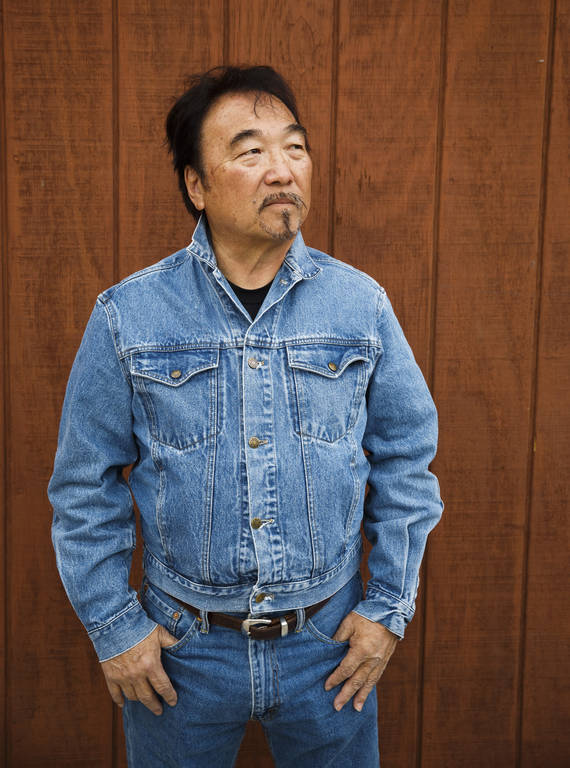
Brian Maeda, 71, was born in Manzanar just nine months before the camp’s closure. Maeda is currently working on a film about the controversial incarceration of Japanese-Americans deemed disloyal to the United States.
PATRICK T. FALLONThe debate extends to which words to use to describe the camps. Officially called “relocation centers,” they have since been widely described as “internment camps,” but some, including people who were incarcerated there, object on the grounds that the word “internment” applies to the imprisonment of enemy nationals, which followed American and international law. They say their detention was illegal, and they argue for the use of the term “incarceration” instead. In recent years, the phrase “concentration camp” has been gaining momentum, even though Japanese-Americans acknowledge their experience was vastly different from the atrocities that took place in Nazi death camps.
Interpreting Manzanar’s history is the culmination of a lifelong passion for Lynch. She checked out library books about Japanese culture at a very early age, and when she was 9, the movie “Farewell to Manzanar” made a big impression on her. At 13, she stopped by Manzanar on a family trip. She was hooked. “The hair stood up on the back of my neck, and I just felt the power of this place,” she said. After an itinerant Park Service career took her from Yosemite to Mount Rainier, she landed her dream job as Manzanar’s chief of interpretation more than 15 years ago. As movers packed up her belongings, the terrorist events of Sept. 11 unfolded. Manzanar was pushed into the limelight after Japanese-Americans denounced the singling out of American Muslims, and media turned their attention to the site.
As a 20-year-old, Amara Munir has lived most of her life in a post-9/11 world.Last spring, the college student joined the pilgrimage; it was her first visit to Manzanar. Inside the World War II-era mess hall, she said she was struck by the living conditions, especially the communal bathrooms that offered no privacy. While camp life is hard to fathom, the discrimination that led to it feels very real to her. She fears her attire identifies her as a potential target for abuse.

National Parks
You can read this and other stories about history, nature, culture, art, conservation, travel, science and more in National Parks magazine. Your tax-deductible membership donation of $25 or more entitles…
See more ›“I’m a Muslim wearing a hijab, so when you see me you see a Muslim person,” she said.
Munir said she is grateful for the show of support from the Japanese-American community. For the past 11 years, the Council on American-Islamic Relations has sent a group of students to the pilgrimage, and Muslim leaders have made speeches at the event. This kind of outreach has become a priority for many survivors of the camps. For the past decade, Joyce Nakamura Okazaki has been giving presentations about her Manzanar experience to students in Los Angeles-area schools. She also routinely responds to inquiries from students who are writing papers on the topic and has helped finance student trips to Manzanar.
For a long time, such openness was rare: People incarcerated in the camps often refrained from sharing their memories because they felt shame at their inability to protect their family from harm or found it difficult to relive the trauma of camp life. Others worried that bringing up the past would exacerbate other Americans’ prejudices, which lingered after the war. But after decades of healing and an official apology from President Ronald Reagan, many of those who are still alive feel compelled to speak.
After the pilgrimage’s speeches, interfaith service and traditional dance had concluded and she was done packing leftover programs and commemorative T-shirts, Pat Sakamoto said her mother was one of those who remained silent. Born in Manzanar, Sakamoto has few direct memories of the experience, but every year she uses the pilgrimage as an opportunity to tell the story of her mother, who cared for two young daughters in camp after her husband’s answers to the loyalty questionnaire led to his detention at the Tule Lake camp in California and, ultimately, his exile to Japan. “Because she couldn’t give voice to it, I have to do it for her,” she said.
A couple of hours after most buses had left, a fraction of the attendees found their way to the Lone Pine High School gymnasium for Manzanar at Dusk. Modeled after a similar program at the pilgrimage to Tule Lake, the event is meant to encourage dialogue between generations and keep the Manzanar story current. Students, some of them grandchildren of people incarcerated at Manzanar, have taken ownership of the program.
Camp survivors used to make up the majority of the crowd at the pilgrimage. This year, fewer than 200 made the trip, but pilgrimage organizers and park officials are buoyed by the commitment of a new generation of advocates. “The story is in good hands,” Lynch said.
After the readings, the students led small-group discussion sessions. Then participants walked up to the microphone to share personal impressions, recollections and songs. One of them was a 55-year-old woman whose mother died in November. Exposed to the day’s cold wind and dust, she said she finally understood why her mother had covered her plate of food with a napkin or a lid all her life, even though her mother herself had forgotten the reason. The woman’s voice trembled when she urged those present to make their relatives talk and collect their stories because doing so “heals them.”
About the Photographer
It had been an emotional ending to an emotional day. When Darren Kawasaki exited the building, he was drained. The 20-year-old student estimated that this was his 11th trip to Manzanar, the camp where his grandfather was incarcerated during the war. For Kawasaki, the passing of the generation of camp survivors is personal, as his grandfather’s health is deteriorating. He is glad Manzanar exists because he will have a place to return to after his grandfather is gone.
“My last connection with him will be this camp,” he said before excusing himself, crossing the street and heading to his car.
About the author
-
 Nicolas Brulliard Senior Editor
Nicolas Brulliard Senior EditorNicolas is a journalist and former geologist who joined NPCA in November 2015. He serves as senior editor of National Parks magazine.
